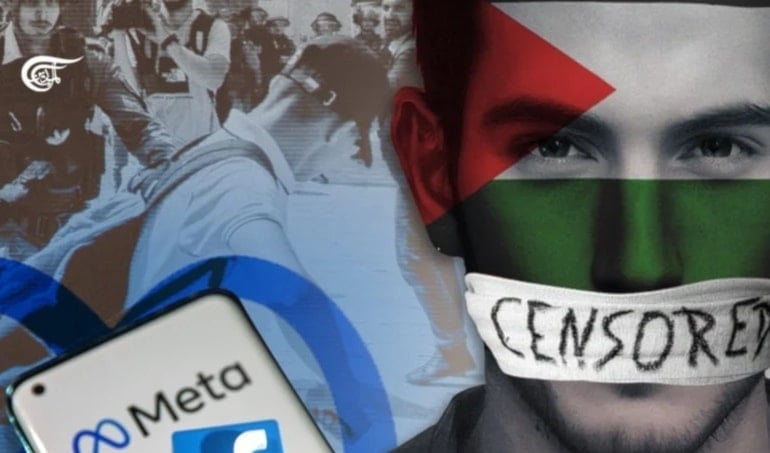Digital apartheid? Report exposes anti-Palestine social media bias
From Gaza to global platforms, Palestinian voices are being shadowbanned, suspended, and erased, according to Sada Social’s new report.
-

A majority of respondents reported censorship of content related to Gaza, Resistance, and solidarity campaigns (Illustrated by Al Mayadeen English)
As "Israel’s" war on Gaza intensified throughout 2024, Palestinian voices across global social media platforms have been met with a parallel campaign of digital repression. A newly released report by Sada Social, a Palestinian digital rights watchdog, exposes the widespread and systematic censorship targeting Palestinian content online.
Walid El Houri, West Asia & North Africa Editor at Global Voices, also reported extensively on the issue, highlighting the alarming scope of digital suppression as part of a broader effort to silence Palestinian narratives.
A targeted campaign?
The Digital Rights Index 2024, published in April, documents over 25,000 violations of Palestinian digital expression. These include content takedowns, shadow bans, account suspensions, and algorithmic suppression, coinciding with what the International Court of Justice has called a “plausible” case of genocide in Gaza.
According to the report, the most affected platforms were Instagram (31%), TikTok (27%), Facebook (24%), and X (12%). Smaller but notable cases were also recorded on platforms like YouTube and SoundCloud.
Sada Social found that Palestinian posts documenting airstrikes, mourning victims, or expressing solidarity were disproportionately targeted. Many users were permanently locked out of their accounts, often without explanation or due process.
“These actions have a profound impact on freedom of expression,” the report states, “particularly during wartime, when digital platforms serve as one of the few avenues for Palestinians to document atrocities and appeal to the world.”
Journalists and media outlets face systematic restrictions
Alarmingly, 29% of the recorded violations impacted journalists and media outlets, with women journalists making up 20% of that group. Restrictions included post removals, visibility limits, and outright account bans, effectively silencing those reporting from Gaza and the West Bank.
International media often rely on Palestinian journalists for ground-level coverage. Censoring their voices not only erases Palestinian narratives but also compromises the global public's ability to stay informed about events on the ground.
The report also notes that suppression extended beyond wartime imagery. “Censorship wasn’t limited to images of massacres,” it explains, “but also extended to content related to the assassination of Ismail Haniyeh in Tehran, even when devoid of political context.” Phrases such as “Death to Israel” and “Death to America” were among those flagged and removed, raising serious questions about digital editorial neutrality and freedom of expression.
Double standards in moderation and incitement
While Palestinian users face widespread moderation, the report highlights a disturbing double standard: incitement and hate speech against Palestinians often go unchecked, especially on platforms such as Telegram (41%) and X (35%).
Sada Social recorded over 87,000 instances of incitement in 2024, ranging from calls for ethnic cleansing to dehumanizing language. Much of this content, it says, originated from Israeli officials, soldiers, and influencers.
The report describes this as a reflection of “official policies aimed at gaining political and military advantages by promoting hate speech and manipulating global public opinion.” It also catalogs 51 recurring anti-Palestinian narratives designed to rationalize Israeli aggression and delegitimize pro-Palestinian activism and humanitarian work.
How algorithms enforce censorship beyond borders
A public opinion survey conducted by Sada Social among Palestinian communities both inside and outside occupied Palestine underscores the global nature of this repression. A majority of respondents reported censorship of content related to Gaza, Resistance, and solidarity campaigns.
Key findings include:
- Facebook: 68.4% of users experienced restrictions
- Instagram: 65.8%
- TikTok: 36.2%
- X: 14.5%
Most censored content categories:
- Martyr commemorations (86.8%)
- Documentation of "Israeli" aggression (60.5%)
- Expressions of solidarity with Palestine (53.3%)
- Mentions of resistance factions (51.3%)
- Coverage of prisoners and detainees (45.4%)
- Calls for boycott (32.9%)
These findings confirm that Palestinian digital censorship is not confined by geography, with users abroad facing similar restrictions as those inside Gaza and the West Bank.
Sada Social concludes that social media platforms are not neutral actors. In a context defined by occupation, apartheid, and asymmetrical warfare, the algorithms, reporting tools, and moderation policies of these platforms function as instruments of broader structural violence.
The organization calls on civil society, digital rights defenders, and international lawmakers to treat digital rights as integral to human rights, especially during war. For Palestinians, digital platforms remain among the few available spaces to mourn, document, and resist. But even these fragile avenues are now under threat by an expanding system of algorithmic repression.

 4 Min Read
4 Min Read










